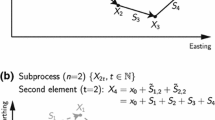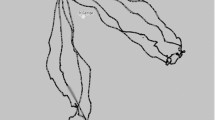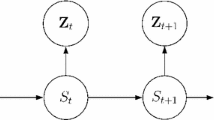Abstract
This paper introduces a simple stochastic model for waterfowl movement. After outlining the properties of the model, we focus on parameter estimation. We compare three standard least squares estimation procedures with maximum likelihood (ML) estimates using Monte Carlo simulations. For our model, little is gained by incorporating information about the covariance structure of the process into least squares estimation. In fact, misspecifying the covariance produces worse estimates than ignoring heteroscedasticity and autocorrelation. We also develop a modified least squares procedure that performs as well as ML. We then apply the five estimators to field data and show that differences in the statistical properties of the estimators can greatly affect our interpretation of the data. We conclude by highlighting the effects of density on per capita movement rates.
Similar content being viewed by others
References
Arnold, S. F. (1990). Mathematical Statistics, Englewood Hills, NJ: Prentice-Hall.
Bailey, N. T. J. (1964). The Elements of Stochastic Processes, New York: John Wiley and Sons.
Bard, Y. (1974). Nonlinear Parameter Estimation, New York: Academic Press.
Bartlett, M. S. (1949). Some evolutionary stochastic processes. J. R. Stat. Soc. Ser. B B11, 211–229.
Carroll, C. J. and D. Ruppert (1988). Transformation and Weighting in Regression, New York: Chapman and Hall.
Chambers, J. M., W. S. Cleveland, B. Kleiner and P. A. Tukey (1983). Graphical Methods for Data Analysis, New York: Chapman and Hall.
Chiang, C. L. (1980). An Introduction to Stochastic Processes and Their Applications, Huntington, NY: Robert E. Krieger Publishing.
Davidian, M. and D. M. Giltinan (1995). Nonlinear Models for Repeated Measure Data, London: Chapman and Hall.
Gauss, C. F. (1823). Theoria combinations observationum erroribus minimis obnoxiae. Pars prior, et Pars posterior. Comment. Societ. R. Sci. Gottingensis Recentiores 5, 33–62, 63–90.
Guttorp, P. (1995). Stochastic Modeling of Scientific Data, London: Chapman and Hall.
Hilborn, R. and M. Mangel (1997). The Ecological Detective: Confronting Models with Data, Princeton, NJ: Princeton University Press.
Judge, J., W. E. Griffiths, R. C. Hill and T.-C. Lee (1980). The Theory and Practice of Econometrics, New York: John Wiley.
Knight, W. (1968). Asymptotic growth: an example of nonsense disguised as mathematics. J. Fisheries Res. Board Can. 25, 1303–1307.
Nash, J. C. and M. Walker-Smith (1987). Nonlinear Parameter Estimation: An Integrated System in BASIC, New York: Marcel Dekker.
Press, W. H., S. A. Teukolsky, W. T. Vetterling and B. P. Flannery (1992). Numerical Recipes in C: The Art of Scientific Computing, New York: Cambridge University Press.
Ratkowsky, D. A. (1983). Nonlinear Regression Modeling: A Unified Practical Approach, New York: Marcel Dekker.
Rawlings, J. O. (1988). Applied Regression Analysis: A Research Tool, Pacific Grove, CA: Wadsworth and Brooks.
Renshaw, E. (1986). A survey of stepping-stone models in population dynamics. Adv. Appl. Probab. 18, 581–627.
Ricciardi, L. M. (1986). Stochastic population theory: birth and death processes, in Mathematical Ecology: An Introduction, T. G. Hallam and S. A. Levin (Eds), Berlin: Springer-Verlag, pp. 155–190.
Ruben, H. (1962). Some aspects of the emigration-immigration process. Ann. Math. Stat. 33, 119–129.
Seber, G. A. F. and C. J. Wild (1989). Nonlinear Regression, New York: John Wiley and Sons.
Stevens, W. L. (1951). Asymptotic regression. Biometrics 7, 247–267.
Taylor, H. M. and S. Karlin (1984). An Introduction to Stochastic Modeling, Orlando, FL: Academic Press.
Vonesh, E. F. and V. M. Chinchilli (1997). Linear and Nonlinear Models for the Analysis of Repeated Measurements, New York: Marcel Dekker.
Wetherill, G. B. (1986). Regression Analysis with Applications, New York: Chapman and Hall.
Whittle, P. (1967). Nonlinear migration processes. Bull. Int. Stat. Inst. 42, 642–647.
Author information
Authors and Affiliations
Rights and permissions
About this article
Cite this article
Silverman, E., Kot, M. Rate estimation for a simple movement model. Bull. Math. Biol. 62, 351–375 (2000). https://doi.org/10.1006/bulm.1999.0159
Received:
Accepted:
Issue Date:
DOI: https://doi.org/10.1006/bulm.1999.0159




